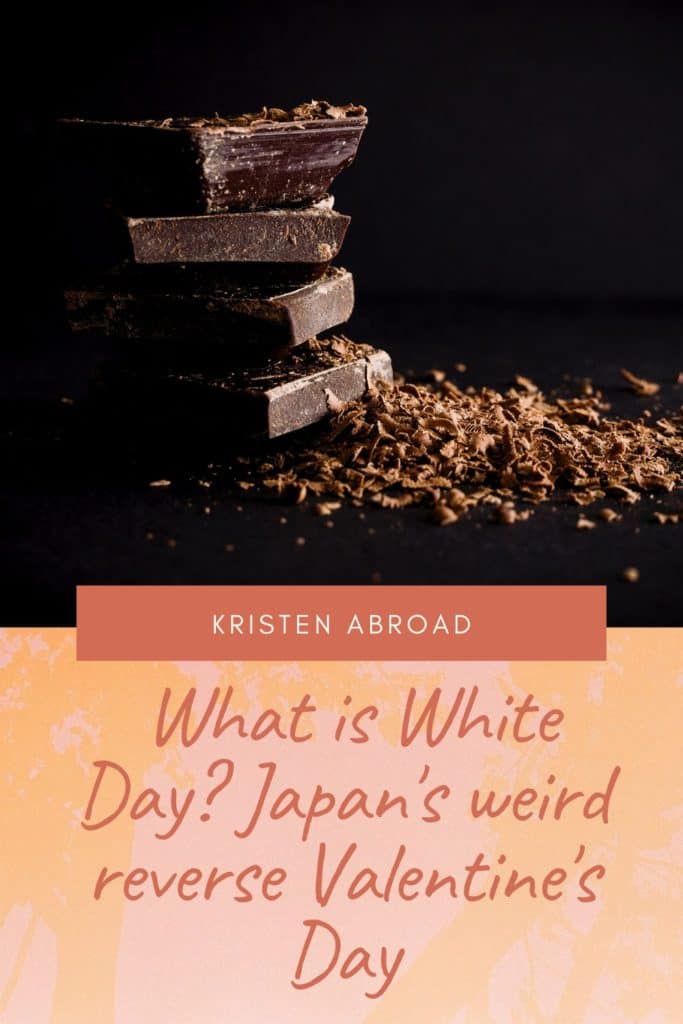If you recall my article on Valentine’s Day in Japan, then you’ll remember that it was purely girls giving chocolate. How’s that fair?! You may ask. May I present to you, White Day, Japan’s reverse Valentine’s Day.
[Editor’s Note: This post was originally published in February of 2019 and has been updated for freshness, accuracy and comprehensiveness.]
History of White Day
Much like Valentine’s Day, the history of White Day is a tad convoluted. If you think of Valentine’s Day as a giant marketing scheme in the US: Japan’s one-upped us with this one. Why have only one massive day for sweet buying, when you could have two?
Okashi (お返し) and Marshmallow Day
There is a huge gift-giving culture in Japan that helps contribute to the concept called “お返し” or “return gift”. In 1977, an executive of the 石村萬盛堂 (Ishimura Manseido) confectionary store in Fukuoka was looking for inspiration. As the story goes, he came across a letter to a women’s magazine where there was a complaint about why don’t men return the favor (okashi) of Valentine’s Day gifts? Why not something “like a handkerchief, candy, even marshmallows…”
Tada! “Marshmallow Day” (マシュマロデー) was born.
What day is White Day?
Ah, but what day should this be? The debate was made between three days according to Ishimura Manseido’s website.
- The inverted day, April 12th? (2/14 = 4/12)
- One week later on the 21st of February
- One month later on March 14th.
The decision was made in a very Goldilocks fashion of “not too close but not too far” and henceforth, White Day occurs exactly a month after Valentine’s Day, on March 14th.
Not so says National Candy Association
全国飴菓子工業協同組合 is a very long set of kanji that usually translates to something like “Nationwide Confectionery Industry Cooperative Association” tells a slightly different story. They state that in 1978 and 1979, the 13 companies to make up the co-op came together twice in Tokyo to have discussions about how to sell more candy. That eventually morphs into “White Day Committee Planning meeting”.
You guessed it, as a way to sell more products under the guise as a “payback” day for the ladies that were so nice to hand you chocolate on Valentine’s day.
Why white?
Originally a bunch of names were thrown around but they decided on ホワイトデー (White Day, again fully katakana that is the Japanese pronunciation of the English words). Why? Because white is the symbol of purity and it could “renew teens love” (yes, they actually say that).
They also magically came to the date of March 14th. For the next ten years, there were elaborately themed campaigns. No mention of the marshmallow day or Ishiwata on the National Candy Association history that I can find.
Third Theory
There’s a third theory of how it began that is circulating around as well though the least likely (and let’s face it, the other two theories at least the companies/associations in question are laying claim to it!). The third theory is that Fujiya created it with a “Mercy Valentine” campaign in 1973. However, there is nothing about that on their company timeline which you would think there would be if it were true after such a lasting impact.
Regardless, it has stuck!
三倍返し (triple the return) and White Day
So somehow over the years, there’s been this perpetuating thought that the amount of money a man must spend on his return gift is 3 times the return or sanbai gaeshi (三倍返し). That kanji makes my head hurt because it’s technically “three – double the returns” so is that six times? But I digress.
Let’s do some quick math. Let’s say, you work in an office with lots of women. So you got 10 obligation chocolates (see my post on Valentine’s Day for more on the different types of chocolate). Even if it’s 100 yen apiece, that’s $30 USD. Get more like 300 yen and you’re pushing $100 USD!
Don’t worry, Yahoo did surveys and most spend much more like 1.2 times the amount. That still adds up but the point is, don’t feel obligated to go crazy. At least from the stand point of this one American female that has been getting White Day gifts from my male Japanese coworkers for 6 years. They usually all chip in and get me a box of cookies!
White Day around the world
In recent years, the custom has started to move to other Asian cultures. As in America, Valentine’s day is more of a man giving gift days, do you think that one day we may end up with a reverse white day? Where girls give the return gifts? Let me know in the comments!


OoOoOo This sounds like it could get intense! But how fun in the spirit of it all. That’s really fascinating to know that there is a holiday like that, that pays back three fold. I knew about girls giving chocolates/etc from the many shows and anime I watch but interesting. I honestly would love to have a white day…since whites my favorite color. I may have to get my husband on board hehehe.
You should completely get on board with starting it back stateside! I think it’s really fun. Granted I end up with this giant pile of chocolate but that’s why I run, right? 🙂
Since i’ve been into japanese culture, i give chocolates during valentines day to mostly male colleagues. Hahaha!
Love it! It’s so much fun, I think.